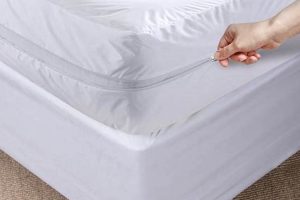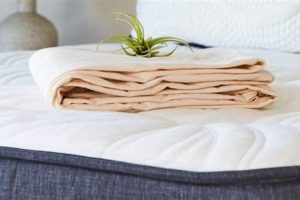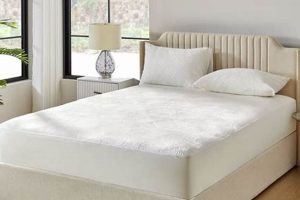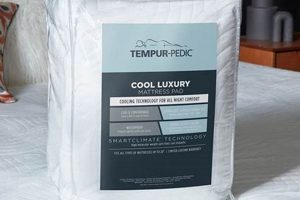A bedding encasement designed to prevent the habitation of microscopic arthropods and allergens within a sleep surface functions as a barrier. These specifically constructed covers, typically composed of tightly woven fabrics or laminated materials, deny access to the mattress core, mitigating the accumulation of organic debris that serves as a food source. A common example of such a product is a zippered cover applied to a bed to create an impermeable layer.
The utilization of such protective measures offers considerable advantages for individuals susceptible to allergic reactions or respiratory sensitivities. By minimizing exposure to these common indoor allergens, these covers can contribute to improved sleep quality and reduced symptom severity. Historically, the development of these products has been driven by increasing awareness of the connection between environmental factors and the manifestation of allergic diseases.
This discussion will delve into the characteristics of effective barriers, material compositions, proper selection criteria, maintenance protocols, and other relevant considerations to guide consumers in choosing suitable sleep surface protection.
Guidance on Selecting Effective Bedding Protection
The following recommendations are designed to assist in the proper selection and utilization of bedding encasements intended to minimize exposure to indoor allergens.
Tip 1: Fabric Evaluation: Assess the pore size of the fabric. A tighter weave, typically with pore sizes less than 10 microns, provides a more effective barrier. Fabric density specifications are generally available from manufacturers.
Tip 2: Material Composition: Consider hypoallergenic materials. Woven microfiber fabrics or laminated materials, such as polyurethane, offer good allergen protection while minimizing potential for irritation.
Tip 3: Zippered Enclosure: Ensure the presence of a secure, fully enclosed zipper system. Exposed mattress areas can negate the benefits of the encasement. Seek out zippers with fabric flaps that provide an additional barrier.
Tip 4: Allergen Certification: Look for certifications from reputable organizations. Certifications indicate the product has been independently tested and meets established allergen barrier standards.
Tip 5: Maintenance Procedures: Follow the manufacturer’s cleaning instructions. Regular washing, typically every one to two months, is necessary to remove accumulated surface allergens. Use hot water (at least 130F or 54.4C) when laundering.
Tip 6: Mattress Age and Condition: New mattress encasements are most effective. Older mattresses may contain significant allergen build-up, requiring more intensive initial cleaning or even replacement.
Effective bedding protection offers a proactive approach to mitigating allergen exposure within the sleep environment, contributing to enhanced well-being for susceptible individuals.
Consider these recommendations in conjunction with other environmental control measures for comprehensive allergen management.
1. Barrier Fabric
The effectiveness of a sleep surface encasement in mitigating allergen exposure is directly correlated with the properties of the barrier fabric. This fabric serves as the primary defense against the ingress and egress of microscopic arthropods and their allergenic byproducts.
- Pore Size and Density
The pore size of the fabric is a critical determinant of its efficacy. A smaller pore size, typically measured in microns, restricts the passage of allergens. Densely woven fabrics, such as tightly woven microfibers, demonstrate superior barrier properties compared to loosely woven materials. For example, a fabric with a pore size of 6 microns or less will prevent the passage of most common household allergens.
- Material Composition and Construction
The material composition of the barrier fabric influences its durability, breathability, and allergen-blocking capabilities. Synthetic materials like polyester and nylon, or laminates like polyurethane, are often used for their impermeability. The construction method, such as weaving or knitting, also affects the fabric’s performance. Tightly woven fabrics are generally more effective barriers. For example, a tightly woven polyester fabric offers a balance of comfort and protection.
- Air Permeability and Moisture Vapor Transmission
While acting as an allergen barrier, the fabric should allow for adequate air circulation and moisture vapor transmission. Excessive impermeability can lead to discomfort and moisture accumulation, potentially creating an environment conducive to mold growth. Balance between barrier protection and breathability is necessary. For instance, some laminated fabrics incorporate microporous membranes to allow moisture vapor to escape while blocking allergens.
- Durability and Maintenance
The longevity and maintainability of the barrier fabric are essential considerations. The fabric must withstand repeated washing and regular use without compromising its barrier properties. Durable fabrics that can be laundered in hot water are preferred. For example, a high-quality, tightly woven polyester fabric can withstand frequent washing and maintain its integrity over time.
The characteristics of the barrier fabric are paramount in determining the overall effectiveness of sleep surface encasements. Careful consideration of pore size, material composition, air permeability, and durability ensures optimal allergen protection and long-term performance.
2. Zipper Security
The integrity of the zipper closure on a sleep surface encasement directly influences its effectiveness as a barrier against microscopic arthropods. A compromised or inadequately designed zipper can negate the protective function of the encasement, permitting the passage of allergens and undermining the intended benefits. Consequently, a robust and properly secured zipper mechanism constitutes a critical element in ensuring a truly effective sleep surface protector. For instance, if a zipper lacks a tight seal or is easily damaged, it becomes a potential entry point for allergens, rendering the surrounding fabric barrier largely irrelevant. A real-world illustration can be found in scenarios where individuals experience continued allergic symptoms despite using an encasement; upon closer inspection, a faulty zipper is often identified as the cause.
Practical application of this understanding involves meticulous inspection of the zipper prior to purchase and during routine maintenance. Features such as a tightly woven fabric flap covering the zipper, a self-locking mechanism, and reinforced stitching around the zipper track contribute to enhanced security and durability. These design elements minimize the risk of allergen leakage and extend the lifespan of the encasement. Regular washing and drying should also be performed according to the manufacturer’s instructions to prevent zipper damage and maintain its functionality. Furthermore, the zipper material should be chosen for its resistance to wear and tear, with options like nylon or metal providing greater longevity compared to cheaper alternatives.
In summary, zipper security is paramount to the overall efficacy of a sleep surface encasement. A deficient zipper compromises the entire protective system, regardless of the quality of the surrounding fabric. Therefore, selecting encasements with robust, well-designed zipper closures and implementing diligent maintenance practices are essential steps in achieving effective allergen control within the sleep environment. Challenges may arise in identifying subtle zipper defects, underscoring the importance of thorough inspection and informed purchasing decisions.
3. Pore Size
The dimension of microscopic openings within the fabric of a sleep surface encasement, designated as pore size, directly dictates its effectiveness in preventing the passage of allergenic particles. This parameter represents a critical specification in evaluating the protective capabilities of a bedding encasement designed to mitigate exposure to indoor allergens.
- Micron Rating and Allergen Exclusion
The pore size, measured in microns (m), defines the maximum particle diameter that can permeate the fabric. Effective barriers typically exhibit pore sizes below the dimensions of common household allergens, such as microscopic arthropod waste and fragments. For instance, allergens typically range from 1 to 10 m, necessitating a fabric pore size of less than 10 m, and ideally less than 6 m, to provide substantial protection. Real-world scenarios demonstrate that encasements with larger pore sizes fail to prevent allergen passage, resulting in continued allergic symptoms.
- Fabric Density and Weave Type
The pore size is intrinsically linked to the density and weave type of the fabric. Tightly woven fabrics, characterized by a high thread count and interlocked fibers, exhibit smaller pore sizes. Conversely, loosely woven or knitted fabrics possess larger pores, compromising their barrier function. For example, a tightly woven microfiber fabric generally provides superior allergen protection compared to a loosely knitted polyester fabric.
- Lamination and Coating Technologies
Certain sleep surface encasements incorporate lamination or coating technologies to reduce pore size and enhance barrier properties. These techniques involve applying a thin, impermeable layer to the fabric surface, effectively sealing the pores. Polyurethane and polyethylene films are commonly used for lamination. However, such treatments can impact breathability. As an illustration, a laminated encasement offers excellent allergen protection but may trap moisture, leading to discomfort for some users.
- Testing and Certification Standards
Standardized testing methods exist to determine the pore size and allergen barrier properties of fabrics used in sleep surface encasements. Independent certification programs, such as those offered by the Asthma and Allergy Foundation of America (AAFA), verify that products meet established performance criteria. Certification provides assurance to consumers regarding the product’s effectiveness. For instance, an encasement bearing the AAFA certification has undergone rigorous testing to demonstrate its ability to block common allergens.
The correlation between pore size and allergen protection underscores the importance of selecting sleep surface encasements with demonstrably small pore dimensions. A thorough understanding of this parameter, in conjunction with considerations regarding fabric density, weave type, lamination techniques, and certification standards, facilitates informed purchasing decisions and promotes effective allergen management within the sleep environment. Choosing materials and construction methods with small pore size are crucial to create effective protectors.
4. Material Integrity
The durability and resilience of the materials comprising a bedding encasement, termed “material integrity,” are fundamentally linked to its sustained ability to function as a “mattress protector dust mite proof” barrier. The intended function of the protector relies on the continuous and complete physical separation of the mattress core from the external environment. Compromises to material integrity directly undermine this function, reducing the protector’s efficacy and longevity. For instance, if the fabric of the protector tears or delaminates after repeated washing, its capacity to block microscopic arthropods and allergens is diminished, potentially leading to increased allergen exposure.
Material integrity is a key attribute assessed through standardized testing procedures and impacts consumer confidence in a product’s performance. Factors such as tensile strength, tear resistance, seam strength, and resistance to degradation from laundering directly contribute to a material’s overall integrity. Protectors constructed from lower-quality materials may exhibit premature wear, seam failures, or loss of barrier properties, negating their intended function. In practical terms, an encasement with high material integrity will withstand regular use and cleaning without compromising its protective barrier, while a product with low material integrity will require more frequent replacement, increasing overall cost and potentially exposing the mattress to allergens.
Sustained functionality of a bedding encasement requires materials engineered for both durability and allergen impermeability. Breaches in material integrity, whether from physical damage, chemical degradation, or inadequate construction, lead to a loss of dust mite barrier properties. Careful selection of encasements constructed from robust, resilient materials, coupled with proper care and maintenance, is necessary to achieve effective and prolonged allergen control within the sleep environment. Manufacturers that invest in robust materials and testing methods will ultimately produce products that achieve and maintain a “mattress protector dust mite proof” status.
5. Certified Performance
The designation “mattress protector dust mite proof” implies a defined level of performance in preventing microscopic arthropods and their allergenic detritus from penetrating a sleep surface. “Certified Performance” provides quantifiable validation that a product meets established standards for allergen impermeability, ensuring it fulfills its intended purpose. This certification acts as a reliable indicator for consumers, confirming that the protector has undergone independent testing and adheres to specific performance benchmarks. The absence of such certification introduces uncertainty regarding the product’s actual efficacy in preventing allergen migration, potentially rendering it ineffective. For example, an encasement bearing certification from the Asthma and Allergy Foundation of America (AAFA) has been independently tested and verified to meet defined allergen barrier standards. This offers a higher degree of assurance compared to non-certified products, whose allergen-blocking capabilities remain unverified.
The practical significance of “Certified Performance” extends beyond mere marketing claims. It allows healthcare professionals to confidently recommend products known to contribute to improved indoor air quality and reduced allergen exposure for sensitive patients. Standardized testing methodologies employed during the certification process assess parameters such as pore size, fabric permeability, and zipper security, providing a comprehensive evaluation of the protector’s overall performance. This detailed assessment aids in differentiating between protectors that genuinely provide allergen barrier protection and those that offer only superficial coverage. Furthermore, consistent adherence to certification standards promotes continuous improvement in product design and manufacturing processes, leading to enhancements in the performance and durability of bedding encasements. Protectors with certified performance offer a more effective strategy for managing allergen exposure during sleep.
In summary, “Certified Performance” is an indispensable element of a truly “mattress protector dust mite proof” product. It validates that the protector meets established standards for allergen impermeability, enabling consumers and healthcare providers to make informed decisions. While challenges may arise in ensuring consistent and rigorous enforcement of certification standards across the industry, the presence of a reputable certification mark remains a critical indicator of a product’s ability to effectively mitigate allergen exposure within the sleep environment. Mattress protectors carrying certification logos offers end-users an increase in the reliability.
Frequently Asked Questions
The following section addresses common inquiries regarding the selection, utilization, and effectiveness of bedding encasements designed to mitigate exposure to microscopic arthropods.
Question 1: How frequently should sleep surface encasements be laundered?
Bedding encasements should undergo laundering every one to two months. This practice removes accumulated surface allergens and maintains the integrity of the barrier fabric.
Question 2: What water temperature is recommended for laundering encasements?
Hot water, specifically a temperature of at least 130 degrees Fahrenheit (54.4 degrees Celsius), is advised for laundering. Elevated temperatures effectively eliminate microscopic arthropods and denature allergenic proteins.
Question 3: Do all encasements effectively block allergens?
Not all encasements provide equivalent protection. The effectiveness of a bedding encasement depends on factors such as fabric pore size, material composition, zipper security, and the presence of certified performance. Select encasements that meet established allergen barrier standards.
Question 4: Can encasements eliminate pre-existing allergens within a mattress?
Encasements primarily function as a barrier to prevent new allergen accumulation. Older mattresses may contain substantial allergen build-up. Thorough mattress cleaning or replacement may be necessary in such cases.
Question 5: What material characteristics are indicative of a high-quality encasement?
Desirable material characteristics include tightly woven fabrics with pore sizes less than 10 microns, hypoallergenic composition, breathability, durability, and resistance to damage from laundering.
Question 6: How does zipper security affect the overall effectiveness of an encasement?
A compromised zipper negates the protective function of the encasement. The zipper must be fully enclosed, securely fastened, and preferably covered by a fabric flap to prevent allergen escape.
Proper selection and maintenance of bedding encasements contribute significantly to reducing allergen exposure and improving indoor air quality within the sleep environment.
The subsequent section will provide guidance on evaluating various product types and assessing their suitability for individual needs.
Conclusion
This exposition has elucidated the characteristics, selection criteria, and maintenance protocols essential for achieving effective sleep surface protection. A “mattress protector dust mite proof” designation hinges on a confluence of factors: barrier fabric integrity, secure zipper enclosure, appropriately sized pores, durable material construction, and validated performance through certification. Each element contributes to the overall capacity of the encasement to impede allergen passage and improve indoor air quality.
The informed selection and diligent maintenance of a “mattress protector dust mite proof” product represent a proactive step towards mitigating allergen exposure and fostering a healthier sleep environment. Continued research and adherence to established standards are vital to ensuring the efficacy and longevity of these protective measures, promoting well-being for sensitive individuals. It is imperative that manufacturers continue to innovate and prioritize the development of effective allergen barrier solutions.







